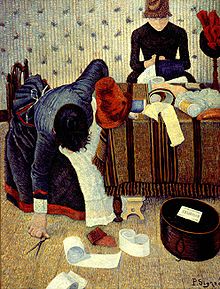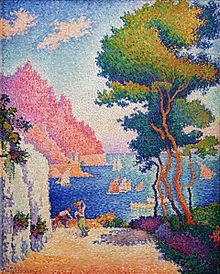Paul Signac

Paul Signac (born November 11, 1863 in Paris ; † August 15, 1935 there ) was a French painter and graphic artist and next to Georges Seurat the most important artist of Neo-Impressionism and Pointillism .
Life
Signac was a self-taught artist . His artistic role model was initially Claude Monet and the Impressionists. However, he rejected their idea of spontaneous search and advocated a stricter, through-composed style of painting in the sense of classics such as Eugène Delacroix .
In 1884 he met Georges Seurat and developed divisionist painting with him . For their painting they made use of new scientific discoveries in color theory and suddenly placed pigments of the pure color in innumerable dots next to each other. In contrast to the Impressionists , they no longer mixed the color on the palette or on the canvas, but left this to the eye of the beholder. The luminosity of this unmixed, unclouded color is optimally preserved. In the same year Signac founded the Société des Artistes Indépendants together with other artists . In 1885 he and Seurat met Camille Pissarro , who also discovered and adapted this style of painting for himself. In 1886 the three exhibited as a group together with Pissarro's son in a separate room at the 8th Salon des Indépendants .
From 1888 Signac was drawn to the ideas of anarchism . He developed a friendship with Jean Grave and published in Les Temps nouveaux . From 1896 onwards he donated some of his works to a raffle for the journal. In 1902 he released some drawings for Guerre-Militarisme (War Militarism), in which Grave wrote the foreword and Maximilien Luce and Théophile Alexandre Steinlen contributed further illustrations. He also published in Le Père Peinard (1894–1899) by Émile Pouget .
Signac's main theme was landscape paintings in bright, bright colors. He was particularly interested in sailing ships and the world of ports.
In 1904 Signac traveled to Venice and took with him more than 200 informal little watercolor sketches from his stay . He carefully worked out the studies in Saint-Tropez in the south of France and created eleven oil paintings that same year .
In addition to his practical work as a painter, Signac also distinguished himself as a theoretician . Programmatically is his 1899 essay "D'Eugène Delacroix au neo- impressionisme" ("From Eugène Delacroix to Neo-Impressionism").
Signac was already a recognized and respected artist during his lifetime. In 1911 he was named chevalier de la légion d'honneur (Knight of the Legion of Honor ), in 1926 as an officier de la légion d'honneur (Officer of the Legion of Honor) and finally in 1933 as commandeur de la légion d'honneur (Commander of the Legion of Honor). Since 1915 he was Peintre Officiel de la Marine , an official naval painter of the French Navy with officer rank.
Works (examples)
- Der Schnee, Bois, 1886, oil on canvas, 34.3 × 45.7 cm, private collection
- Large pine near St. Tropez , 1892–1893 ( Hermitage , Saint Petersburg )
- The red buoy ( La bouée rouge ), 1895, ( Musée d'Orsay , Paris)
- St. Tropez - La Ville et les Pins , 1892, 65 × 81 cm, private collection
- View of the port of Marseille , 1905 ( Metropolitan Museum of Art , New York)
- Venice, the pink cloud , 1909, ( Albertina (Vienna) )
- Antibes le Soir , 1914 ( Musée d'Art Moderne et Contemporain de Strasbourg , Strasbourg)
- Lighthouse at Groix , 1926 (Metropolitan Museum of Art, New York)
- Seine Bridge , 1912 Folkwang Museum
Exhibitions
In 1964, his works were shown in the hand drawings department at documenta III in Kassel .
literature
- Erich Franz: Colors of Light . Edition Tertium, 1996. ISBN 3-930717-38-7
- Herbert Wotte: Paul Signac (series painter and work). VEB Verlag der Kunst, Dresden 1987. ISBN 3-364-00069-7
Individual evidence
- ^ Dictionnaire biographique, mouvement ouvrier, mouvement social , "Le Maitron": notice biographique .
- ^ The late impressionists (Per Amann, Berghaus Verlag)
Web links
- Literature by and about Paul Signac in the catalog of the German National Library
- Materials by and about Paul Signac in the documenta archive
- Paul Signac at artfacts.net
- Small feature from Radio Chiflado about Signac and his relationship to anarchism [1]
| personal data | |
|---|---|
| SURNAME | Signac, Paul |
| BRIEF DESCRIPTION | French painter and printmaker |
| DATE OF BIRTH | November 11, 1863 |
| PLACE OF BIRTH | Paris |
| DATE OF DEATH | August 15, 1935 |
| Place of death | Paris |



